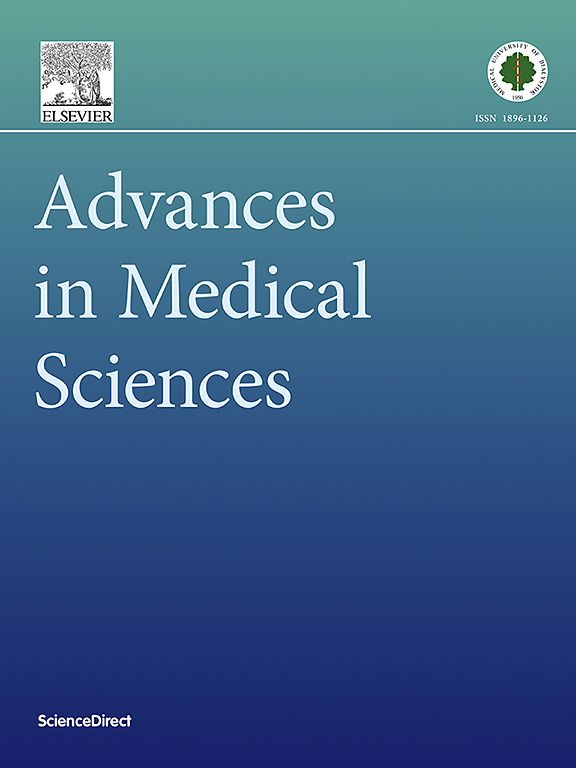波兰胃癌患者PTEN位点遗传不稳定性及miRNA-21和miRNA-200a表达改变
IF 2.6
4区 医学
Q3 MEDICINE, RESEARCH & EXPERIMENTAL
引用次数: 0
摘要
目的:胃癌往往诊断较晚,长期预后较差。该研究的目的是寻找与胃癌发生有关的具有诊断或预后意义的非侵入性潜在生物标志物。材料/方法:对诊断为胃癌的患者,分别从胃的三个不同区域收集胃组织样本,包括原发肿瘤、宏观未改变的胃组织和血清。另取对照组血清样本。分析参数为:qPCR法检测PTEN、miRNA-21和miRNA-200a的表达水平,4个微卫星标记检测PTEN位点LOH/MSI频率。结果:得到的结果显示PTEN在胃肿瘤组织中的表达明显降低,不同胃区组织样本间差异有统计学意义。与没有遗传不稳定的患者相比,LOH/MSI患者的PTEN表达减少了两倍,这表明基因沉默的潜在机制。PTEN沉默的另一个机制可能与miRNA活性有关:PTEN与所研究的miRNA表达水平呈显著负相关。血清中,患者组miRNA-21表达升高,miRNA-200a表达降低,与对照组比较差异有统计学意义。miRNA-200a的受试者工作特征曲线分析显示灵敏度为92%,特异性为77%。结论:miRNA-21和miRNA-200a可作为胃癌患者与健康人的诊断性生物标志物;然而,它应该在更大的患者群体中得到验证。本文章由计算机程序翻译,如有差异,请以英文原文为准。

Genetic instability at the PTEN locus and altered miRNA-21 and miRNA-200a expression in gastric cancer patients in Poland
Purpose
Gastric cancer is often diagnosed late, and is associated with poor long-term prognosis. The aim of the study was to look for non-invasive potential biomarkers involved in gastric carcinogenesis, with diagnostic or prognostic significance.
Material/methods
Gastric tissue samples, from three different regions of the stomach, including the primary tumor, macroscopically unchanged gastric tissues, as well as serum, were collected from patients diagnosed with gastric cancer. Serum samples were also obtained from a control group. The analyzed parameters were: expression levels of PTEN, miRNA-21 and miRNA-200a using qPCR method and the frequency of LOH/MSI at the PTEN locus using four microsatellite markers.
Results
The obtained results revealed significantly decreased expression of PTEN in gastric tumor tissue and statistically significant differences between the studied tissue samples from different stomach regions. PTEN expression in patients with LOH/MSI was decreased two-fold compared to patients without genetic instability, indicating a potential mechanism of gene silencing. Another mechanism of PTEN silencing could be due to miRNA activity: significant negative correlations were found between PTEN and the studied miRNAs expression levels. In serum, miRNA-21 expression was increased in the group of patients, while miRNA-200a expression was decreased, and the differences were statistically significant compared to controls. Receiver operating characteristic curve analysis for miRNA-200a revealed 92 % sensitivity and 77 % specificity.
Conclusions
The obtained results suggest that miRNA-21 and miRNA-200a could be considered as diagnostic biomarkers differentiating patients with gastric cancer from healthy individuals; however, it should be verified on a larger group of patients.
求助全文
通过发布文献求助,成功后即可免费获取论文全文。
去求助
来源期刊

Advances in medical sciences
医学-医学:研究与实验
CiteScore
5.00
自引率
0.00%
发文量
53
审稿时长
25 days
期刊介绍:
Advances in Medical Sciences is an international, peer-reviewed journal that welcomes original research articles and reviews on current advances in life sciences, preclinical and clinical medicine, and related disciplines.
The Journal’s primary aim is to make every effort to contribute to progress in medical sciences. The strive is to bridge laboratory and clinical settings with cutting edge research findings and new developments.
Advances in Medical Sciences publishes articles which bring novel insights into diagnostic and molecular imaging, offering essential prior knowledge for diagnosis and treatment indispensable in all areas of medical sciences. It also publishes articles on pathological sciences giving foundation knowledge on the overall study of human diseases. Through its publications Advances in Medical Sciences also stresses the importance of pharmaceutical sciences as a rapidly and ever expanding area of research on drug design, development, action and evaluation contributing significantly to a variety of scientific disciplines.
The journal welcomes submissions from the following disciplines:
General and internal medicine,
Cancer research,
Genetics,
Endocrinology,
Gastroenterology,
Cardiology and Cardiovascular Medicine,
Immunology and Allergy,
Pathology and Forensic Medicine,
Cell and molecular Biology,
Haematology,
Biochemistry,
Clinical and Experimental Pathology.
 求助内容:
求助内容: 应助结果提醒方式:
应助结果提醒方式:


